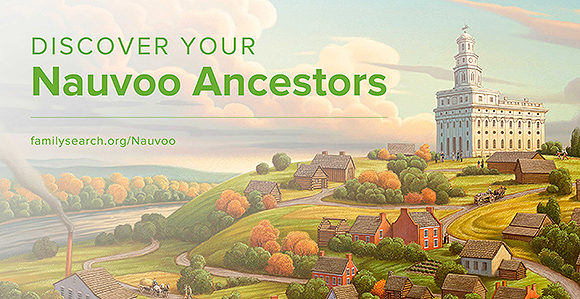NAUVOO NEWS – Do you have an ancestor who may have settled the city of Nauvoo, witnessed the organization of the Relief Society, heard the first cries announcing the martyrdom of Joseph and Hyrum Smith, or helped with the dedication of the Nauvoo Temple?
Perhaps you have ancestral connections to Nauvoo during its formative Church history years and not even know it?
Either way, you could be among the estimated 1.1 million Latter-day Saints who have some connection to Nauvoo why will soon receive an email announcing a new FamilySearch campaign, My Nauvoo Ancestor Story, with email recipients identified by and linked to their Nauvoo ancestors.
By going to My Nauvoo Ancestor Story, users of the new online discovery experience can identify up to 20 ancestors who resided in the early Latter-day Saint settlement in western Illinois any time from 1838 to 1848, with information coming from five database sources providing rich insights into their lives there—even, at times, an eyewitness perspective.
Each of the five sources—BYU’s Nauvoo Community Project, the new historical compilation Saints: The Story of the Church of Jesus Christ in Latter Days, Church History’s Nauvoo Relief Society minutes and Mormon Pioneer Overland Travel databases, and BillionGraves.com—offer information on early Nauvoo residents. My Nauvoo Ancestor Story then weaves together the information from each to offer a more vibrant account of each individual.
“We hope that people will get in and dig deep into this campaign, because they could spend a lot of time with each ancestor,” said FamilySearch’s Roger Dickson, the campaign manager.
The September 9 release date for My Nauvoo Ancestor Story is the same day as the Face to Face worldwide devotional for young adults, with Elder Quentin L. Cook of the Quorum of the Twelve Apostles speaking from Nauvoo.
Both follow the Tuesday, September 4, public release of volume 1 of the four-volume Saints Church history. (See related story.) In fact, since the new tome is created in part from personal histories and mentions names of early Church members from that era, users who have ancestors identified in Saints will be able to click a My Nauvoo Ancestor link to read the excerpt cited.
“Being part of the FamilySearch campaign allows us to reach out to individuals whose family members are the characters in the story,” said Ben Godfrey, the Church History Department’s project manager for Saints.
“Every recipient of the campaign, regardless if they have a direct ancestor in Saints, will be able to link to the stories of the settlement, building up, and eventually abandoning of Nauvoo,” Godfrey added. “It’s a story that’s part of our shared past and will be meaningful to anyone who had ancestors who came through Nauvoo or who are members today of The Church of Jesus Christ of Latter-day Saints.”
Dickson points to the Nauvoo Community Project—from BYU’s Center for Family History and Genealogy—as the key database source for the new campaign.
Students have been researching Nauvoo residents for several years, striving to improve the accuracy of genealogical information, said Jill N. Crandell, director of the BYU center and assistant professor of history. The project’s website contains links to the original courses documenting the lives of these residents and pioneers and adding details to individual stories.
“We anticipate that descendants of Nauvoo residents will appreciate seeing the original documents that name their family members and connect these pioneers to historical places and events,” Crandell said. “The lives of the early Saints can be seen in the context of their experiences and bring greater understanding to the events of their lives.”
FamilySearch patrons using the My Nauvoo Ancestor Story discovery experience can see as many as 20 of their ancestors who lived in Nauvoo. The 20 are listed in order of proximity of relationship to the user.
Facts and information for each ancestor can include full name, photograph, lifespan, relationship to user, age, years residing in Nauvoo, photograph of headstone, and date and place of death. Additional links, when available, provide more information from and links to the five database sources—such as mentions in Saints or citations in the Mormon Overland Trail or Nauvoo Community Project databases.
Also, users can see how the timeline of their ancestors in Nauvoo coincides with the listing of key historical events there, ranging from the Latter-day Saints first residing in what was then known as Commerce, Illinois, through the organization of the Relief Society and the death of the Prophet Joseph Smith, and on to the subsequent dedication of the Nauvoo Temple and the departures to trek westward.
Descriptions of those historical events are linked to chapters in Saints,which in turn provides more details.
While testing the new FamilySearch feature, Dickson said he found ancestors he hadn’t known of previously. One was a young man who lived in Nauvoo and died in his 20s after emigrating to Utah. Curious about the circumstances, Dickson researched through the database links and cited sources and found that his ancestor had been logging in the Mill Creek area. When a friend was crushed by a fallen log, the ancestor ran five miles for help—and then died of heat exhaustion.
“That’s the magic of it,” said Dickson of My Nauvoo Ancestor Story. “There are so many rich data sources, one could spend hours and really have some cool discoveries.”


